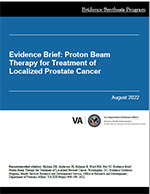
Recommended Citation:
Hickam DH, Anderson JK, Rahman B, Ward RM, Parr NJ. Evidence Brief: Proton Beam Therapy for Treatment of Localized Prostate Cancer. Washington, DC: Evidence Synthesis Program, Health Services Research and Development Service, Office of Research and Development, Department of Veterans Affairs. VA ESP Project #09-199; 2022.
Download PDF: Brief, Supplemental Materials
Risk of early gastrointestinal (GI) and genitourinary (GU) toxicity is possibly lower after treatment with proton beam therapy (PBT) compared with intensity-modulated radiation therapy (IMRT). In the first year after PBT or IMRT, GI toxicity risk may not differ between modalities, while risk of GU toxicity is possibly lower after treatment with PBT compared with IMRT. Underway RCTs could provide important additions to the evidence base on the comparative effectiveness of PBT.
Prostate cancer is the most diagnosed malignant disease among Veterans, and many men choose radiation therapy for initial treatment. Radiation therapy options for prostate cancer include external beam photon therapy, brachytherapy, and PBT. Evidence from direct comparisons of these modalities has high potential value for guiding treatment choice. This report updates a 2015 synthesis of evidence on the benefits and harms of PBT compared to other radiation modalities for treatment of localized prostate cancer.
From 477 potentially relevant articles, 47 studies reported outcomes of treatment with PBT. Ten studies rated as low risk of bias compared PBT to contemporary forms of photon-based radiation therapy. Evidence from 3 studies examining initial treatment of prostate cancer suggests that risk of early GI and GU toxicity is possibly lower after PBT compared with IMRT. Results of 4 studies suggest that in the first year after treatment, GI toxicity risk may not differ between modalities, while GU toxicity risk is possibly lower after PBT compared with IMRT. No pooled findings were statistically significant, and evidence was rated as low strength. Low-strength evidence also suggests that PBT and brachytherapy confer similar overall survival rates, and that GI and GU toxicity rates are similar for hypofractionation and conventional dosing. Single studies reported on quality of life, second malignancy, and overall survival, and it is unclear whether PBT and IMRT differ in these outcomes.